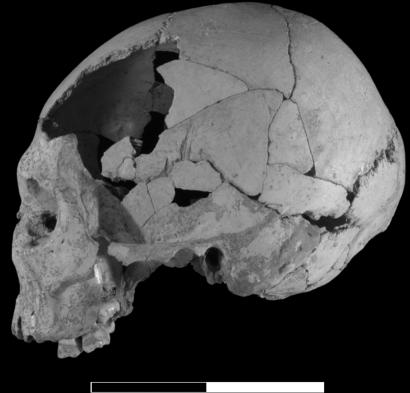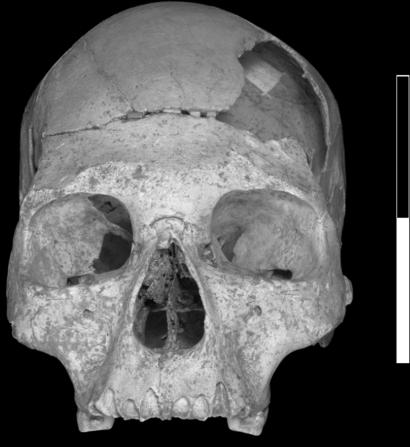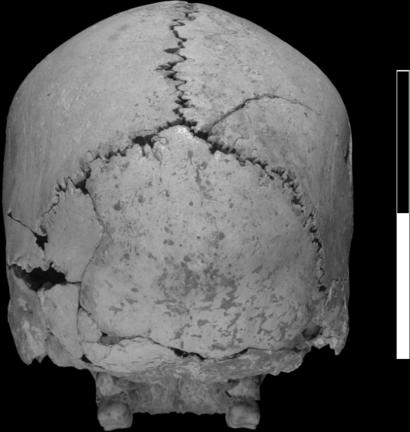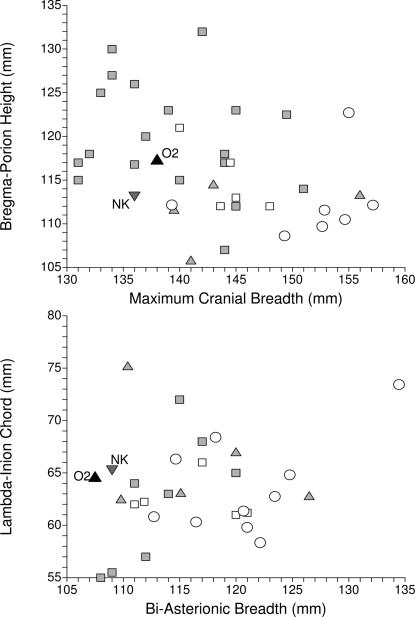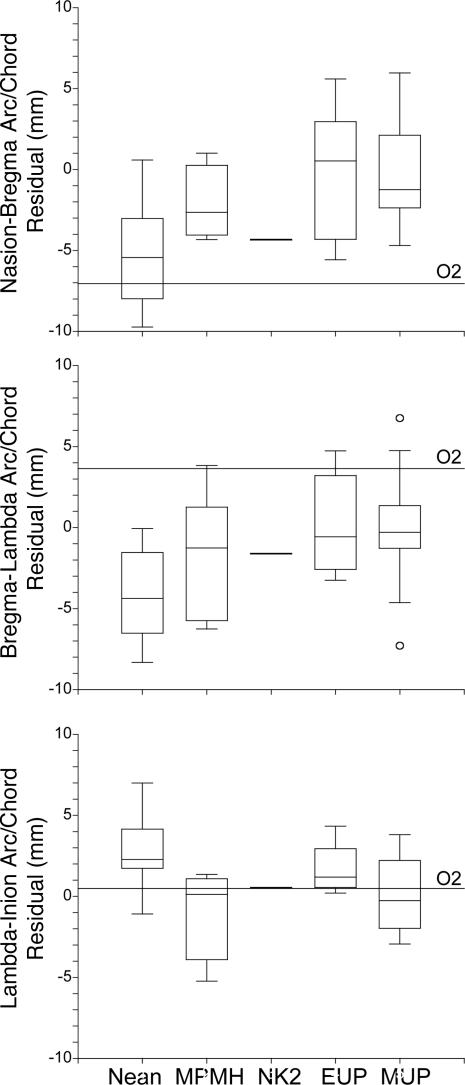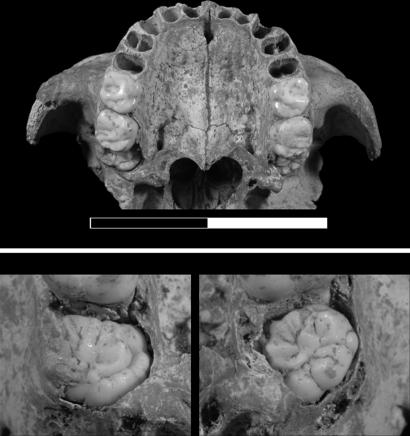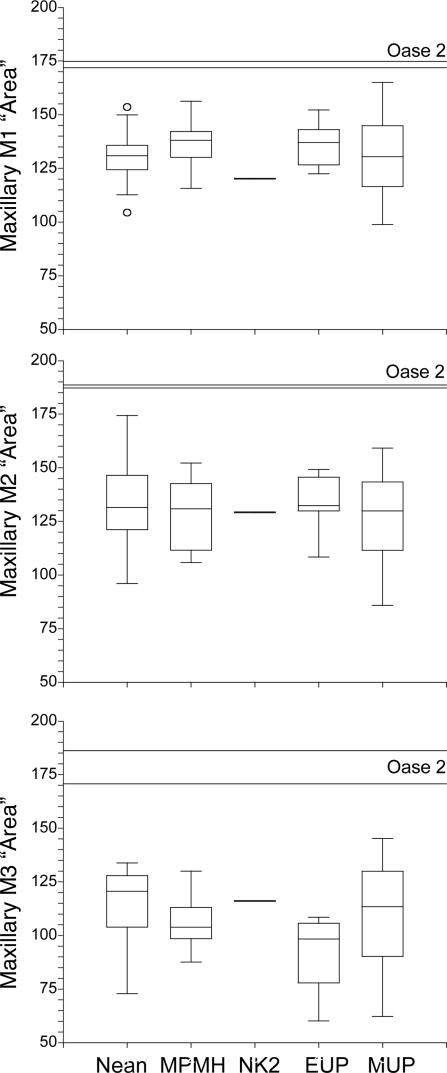Abstract
Between 2003 and 2005, the Peştera cu Oase, Romania yielded a largely complete early modern human cranium, Oase 2, scattered on the surface of a Late Pleistocene hydraulically displaced bone bed containing principally the remains of Ursus spelaeus. Multiple lines of evidence indicate an age of ≈40.5 thousand calendar years before the present (≈35 ka 14C B.P.). Morphological comparison of the adolescent Oase 2 cranium to relevant Late Pleistocene human samples documents a suite of derived modern human and/or non-Neandertal features, including absence of a supraorbital torus, subrectangular orbits, prominent canine fossae, narrow nasal aperture, level nasal floor, angled and anteriorly oriented zygomatic bones, a high neurocranium with prominent parietal bosses and marked sagittal parietal curvature, superiorly positioned temporal zygomatic root, vertical auditory porous, laterally bulbous mastoid processes, superiorly positioned posterior semicircular canal, absence of a nuchal torus and a suprainiac fossa, and a small occipital bun. However, these features are associated with an exceptionally flat frontal arc, a moderately large juxtamastoid eminence, extremely large molars that become progressively larger distally, complex occlusal morphology of the upper third molar, and relatively anteriorly positioned zygomatic arches. Moreover, the featureless occipital region and small mastoid process are at variance with the large facial skeleton and dentition. This unusual mosaic in Oase 2, some of which is paralleled in the Oase 1 mandible, indicates both complex population dynamics as modern humans dispersed into Europe and significant ongoing human evolution once modern humans were established within Europe.
Keywords: cranium, dentition, Neandertals, Upper Paleolithic
It is now well documented that the earliest modern humans emerged from late archaic humans within eastern Africa >100 ka B.P., spread temporarily into extreme southwest Asia and into southern Africa ≈80–100 ka B.P., and extended their geographical range across north Africa and Eurasia sometime after ≈50 ka B.P. (1). The human paleontological record for the Eurasian dispersal has been increasing in both quality and quantity in western Eurasia in recent years, including new discoveries of human remains, direct radiocarbon dating to fossil specimens (both refining the ages of Pleistocene specimens and eliminating from consideration intrusive recent specimens), and refinements in Early Upper Paleolithic (EUP) associations and chronology.
In this context, there is one sample of early modern human craniofacial remains that dates to the first 5 ka of the presumed occupation of Europe [between 42 and 37.5 thousand calendar years before the present (ka cal B.P.)] by early modern humans, the mandible and cranium from the Peştera cu Oase, Caraş-Severin, Romania. The Oase 1 mandible has been described as exhibiting derived modern human features, several generally archaic aspects, and one Neandertal trait (2, 3). The Oase 2 cranium has been described as presenting a similar morphological mosaic based on the portions initially discovered (4, 5). Subsequent fieldwork and analysis have provided a more complete cranium for Oase 2, making it a substantial paleontological reflection of the earliest modern humans to disperse into Europe. That cranium is presented here.
Fieldwork and Discovery of Oase 2
Speleological documentation of a karstic complex in southwestern Romania in 2002 led to the discovery of a previously sealed set of galleries, the Peştera cu Oase (cave with bones; 45°01′N, 21°50′E), and a human mandible lying on its surface. Direct 14C dating of the mandible yielded dates of >35,200 14C B.P. (OxA-11711) and 34,290, +970, −870 14C B.P. (GrA-22810), for a combined age of 40,440 ±1,030 cal B.P. (34,950, +990, −890 14C B.P.) (2). A 2003 field season yielded a partial human cranium on the surface (Oase 2), with exceptional preservation of the splanchnocranium (4). On the basis of these discoveries, systematic surface documentation of the Peştera cu Oase and excavation of the bone bed (the Panta Střamoşilor, slope of the ancestors) that yielded Oase 2 were undertaken in 2004 and 2005 (6).
In addition to cave bear (Ursus spelaeus) and other large mammal remains (7), the excavations yielded sufficient additional segments of Oase 2 to permit the reassembly of a mostly complete cranium (Figs. 1 and 2). With mirror imaging, only portions of the temporal fossae and the basioccipital are missing, and only the anterior face sustained minor abrasion. The preliminary presentation of Oase 2 (4) can now be completed, providing insight into the cranial morphology of the earliest modern Europeans.
Fig. 1.
Oase 2 cranium in norma lateralis left. (Scale bar, 10 cm.)
Fig. 2.
Oase 2 cranium in norma frontalis. (Scale bar, 10 cm.)
The Peştera cu Oase, the Panta Strǎmoşilor, and Oase 2
The Peştera cu Oase consists of two upper galleries immediately below the modern plateau, which originally had openings at their respective ends and into an adjacent dolina near their confluence. The Panta Střamoşilor descends from the gallery confluence toward the lower portions of the karstic system, and it has served as a trap for bones (mostly of U. spelaeus) displaced from the upper galleries. Excavations documented three levels within the Panta Střamoşilor: a surface accumulation, a lower energy hydraulic displacement (Level 1), and a deeper higher energy hydraulic displacement (Level 2). Levels 1 and 2 have yielded a series of 14C dates on bone ≥42 ka cal B.P. (≥37 ka 14C B.P.) and are capped by a stalagmite with a thermal ionization mass spectrometry (TIMS) U-series basal date of 41,620, +2,430, −2,380 cal B.P.
The Oase 2 cranial remains were on the surface of the Panta Střamoşilor, among, slightly below, and even within U. spelaeus bones. The majority was clustered along the wall toward the bottom of the slope, but seven of the vault fragments were scattered ≈2 m upslope. The best reconstruction is that the cranium, when at least partially decomposed, was washed down the Panta Střamoşilor and broke in pieces halfway through, with its bulkier fragments coming to lie in the concavity against the wall. It remains unknown how the Oase 2 cranium or Oase 1 mandible came to be in the Peştera cu Oase; there are no anthropic marks on them or any of the cave contents. There are no carnivore marks on the human bones. All arrangements within the cave appear to be biogenic (from bears, wolves, and small carnivores) and/or hydraulic (6, 7).
Three attempts to directly 14C date Oase 2 have provided only a minimum age for the cranium. Two samples (internal parietal and left frontal squamous) yielded no collagen. A 750-mg sample of posterior parietal fragments was given only a “soft” HCl pretreatment (2%), provided insufficient material to assess its C:N ratio (essential for contamination assessment), and yielded a minimum age of 28,890, +∞, −170 14C B.P. (GrA-24398). Given this minimum age and the morphological similarities to Oase 1 (see Contrasting Characteristic of Oase 2), it is inferred that Oase 1 and Oase 2 were roughly contemporaneous, ≈40.5 ka cal B.P. Even if Oase 2 is younger than Oase 1, it is still at least as old as the early modern European crania from Cioclovina, Mladeč, and Muierii (8–10), and therefore it contributes to our perceptions of the earliest modern European cranial morphology.
The Oase 2 Cranium.
The Oase 2 cranium has been assembled from 38 pieces. The temporal bone was originally attributed to a separate individual given the lack of fit along the parietomastoid suture (4). Subsequent articulation along the squamous suture established that it is part of Oase 2 and that a missing sutural ossicle existed between entomion and asterion (Fig. 1). The bones of the vault fit without perceptible distortion. The assembled neurocranium fits onto the facial skeleton along the left sphenotemporal suture and the frontal squamous, with only a minor gap (≤1 mm) near the midline. The sphenooccipital synchondrosis is entirely patent, and the basioccipital and occipital condyles were not recovered.
Age-at-Death.
In addition to the entirely unfused sphenooccipital synchondrosis, Oase 2 has fully erupted and partially worn upper first molars (M1s) and M2s [stages 3 and 2 (11), respectively], but M3s within their crypts. The M3s have the crown complete and ≈7–9 mm of root formed [stage F (12)]. The formation of M3s is variable and can only indicate a second or early third decade age for Oase 2 (13). However, the sphenooccipital synchondrosis is normally at least partially fused by the mid-second decade and has not been observed fully patent by age 17 (14–17). Oase 2, therefore, most likely died in the mid-second decade.
The extent to which additional growth would have occurred, other than in facial length associated with the eruption of the M3s and possibly superciliary arch hypertrophy, is unclear. A longitudinal comparison of facial length between 13- and 40-year-old recent humans [Fels Longitudinal Study (18)] provides ambiguous results with 3.9% ± 3.7% (n = 43) change in facial length (prosthion–sella length) between those ages. Given the partial eruption of the M3s and the absence of M3 impaction before the Middle Upper Paleolithic (MUP), it is likely that a slight increase in facial length would have occurred to accommodate the M3 crowns in the dental arcade had Oase 2 lived to maturity. Any change in mastoid process height is likely to have been small (see refs. 19–21), and the current height is therefore taken as its mature height.
Oase 2 Versus Oase 1.
The Oase 2 cranium most certainly derives from a different individual than the Oase 1 mandible. They had different ages at death because Oase 1 has fully erupted third molars with modest wear. Although their facial lengths and dental arcade dimensions are similar and they both exhibit molar megadontia, the Oase 1 mandible does not occlude properly with the Oase 2 cranium, and neither exhibits postmortem deformation in the relevant portions.
Modern Human Characteristics of Oase 2.
The Oase 2 cranium exhibits a suite of derived features of modern humans that contrast with those of the Neandertals and align it with preceding Middle Paleolithic modern humans (MPMH) and/or subsequent European Upper Paleolithic modern humans.
Oase 2 has the overall proportions of modern human crania with a moderate maximum length, a large height, and a moderate breadth (Figs. 1–3). The last two measurements show two tendencies between the Neandertals and the three modern human samples (MPMH, EUP, and MUP), with the former having wide and lower neurocrania (Fig. 4). Oase 2 and the penecontemporaneous Nazlet Khater 2 (22) fall with the modern samples. Oase 2 and Nazlet Khater 2 are also close with respect to the relative lengths and breadths of their occipital planes (lambda–inion chord vs. bi-asterionic breadth; Fig. 4) and exhibit fully modern human proportions.
Fig. 3.
Oase 2 cranium in norma occipitalis. (Scale bar, 10 cm.)
Fig. 4.
Bivariate plots of bregma-porion height (M-20) versus maximum cranial breadth (M-8, XCB) (Upper) and lambda–inion chord [M-31(1)] versus bi-asterionic breadth (M-12, ASB) (Lower). Black triangle (O2), Oase 2; gray inverted triangle (NK), Nazlet Khater 2; gray triangles, EUP modern humans; open squares, MPMH; gray squares, MUP humans; open circles, Neandertals. The Neandertal outlier in Lower is Amud 1.
In the facial skeleton, the superciliary arches are modest, separated from the lateral trigones and the orbital margins, and associated with angled superior orbital margins (Fig. 2). The orbits are subrectangular with straight inferior margins. The infraorbital regions have pronounced canine fossae, which form ovoid depressions distinct from the adjacent anterior maxillae.
The superior nasal aperture margins are damaged, but the inferior margin has separate lateral crests with joined turbinal and spinal crests [category 3 (23)] and is level with the nasal cavity floor. The zygomatic bones are sharply angled, such that the zygomaxillary suture faces anteriorly. The nasal aperture is narrow [nasal breadth (M-54) = 25.5 mm; Fig. 2], similar to the apertures of Nazlet Khater 2 (28.4 mm) and more recent human crania (EUP = 26.5 ± 2.4 mm, n = 4; MUP = 25.9 ± 2.1 mm, n = 21) and contrasting with Neandertals (31.9 ± 3.3 mm, n = 14) and MPMH (31.2 ± 1.6 mm, n = 4).
In the temporal region, the keyhole-shaped porous is vertically set and porion is in line with the zygomatic arch. The mastoid process is rounded and laterally bulbous; the convexity is centered on the process rather than anteriorly positioned. The sternocleidomastoideus line arcs across the process, but there is no anterior mastoid tubercle. The slope of the left parietomastoid suture from entomion to asterion is ambiguous given the sutural ossicle; the parietal side is largely horizontal, whereas the temporal side slopes posteroinferiorly from entomion. The right one, however, did not contain an ossicle and slopes slightly posteroinferiorly. The supramastoid crest is weakly developed, and there is no evidence of an angular torus or a lateral nuchal torus.
Computed tomography of the left semicircular canals indicates a relatively superior position for the posterior canal, such that the lateral canal is at the level of the middle of the posterior one. This configuration is characteristic of modern humans, although it is present in a minority of Neandertals (24).
The parietal region is high and rounded (Figs. 1 and 3). In norma lateralis, this is evident in the parietal arc/chord residuals (Fig. 5), in which Oase 2 has one of the highest Late Pleistocene values. In norma occipitalis, the parietal bones curve evenly across the sagittal suture, but there are prominent parietal bosses, and the lateral portions of the bones are straight and vertical. The vertical lateral profile continues onto the mastoid processes, resulting in the “pentagonal” contour of recent humans and distinct from the “ovoid” one of Neandertals in norma occipitalis.
Fig. 5.
Box plots of Oase 2 (O2) and comparative sample linear residuals from the MUP least-squares lines for nasion-bregma (frontal), bregma-lambda (parietal), and lambda–inion (occipital plane) arc versus chord (frontal arc = 1.208 × frontal chord − 5.72, r2 = 0.839, n = 24; parietal arc = 0.991 × parietal chord + 13.33, r2 = 0.858, n = 27; lambda–inion arc = 1.147 × lambda–inion chord − 4.47, r2 = 0.900, n = 8). Comparative samples/specimen: Neandertals (Nean), Middle Paleolithic modern humans (MPMH), Nazlet Khater 2 (NK2), and Early and Middle Upper Paleolithic (EUP and MUP).
The occipital bone is unusual, even for a European early modern human. In norma lateralis, there is a modest occipital bun best described as a “hemi-bun” (25), which is reflected in its arc/chord residual below those of most Neandertals and in the middle of the early modern human distribution (Fig. 5). However, in both norma lateralis and norma verticalis, there is little change in the neurocranial contour at or adjacent to the lambdoid suture. The region of the nuchal line shows only a weak marking for the supreme nuchal lines and a curious tubercle of bone, 11.5 × 5.3 mm, located just superior to inion. The superior nuchal lines are not apparent, and there is no external occipital protuberance, such that inion is located by the change in contour rather than by muscular lines. There is no nuchal torus and no trace of a depression or porosity for a suprainiac fossa.
From these aspects, it is apparent that the Oase 2 cranium exhibits a suite of derived modern human traits that distinguish it from both Neandertal and non-Neandertal archaic Homo. They are sufficient to justify its appellation as an early modern human and align it with the other recent Aurignacian time period European human crania from Cioclovina, Mladeč, and Muierii, and with those from a host of MUP sites.
Contrasting Characteristics of Oase 2.
Oase 2 also presents apparently independent features that are, at best, unusual for a modern human, whether the reference sample is of preceding MPMH or EUP and MUP modern humans.
Despite the high and rounded sagittal parietal arc, the sagittal frontal arc is long and exceptionally flat. The Oase 2 frontal bone arc versus chord residual is below those of all of the early modern human crania; it falls in the middle of the Neandertal range of variation despite the absence of a supraorbital torus (Fig. 5). In combination with its highly curved parietal arc, it is exceptional for an early modern human and is closest to the Shanidar 1 Neandertal. No deformational process can explain this pattern because no postdepositional distortion was observed on any part of the cranium, all of the cranial vault fragments fit perfectly, and no trace of artificial deformation was noticed. Among the early modern humans, Oase 2 is most closely approached by Cioclovina 1 (frontal arc/chord residual: −5.6) and secondarily by Nazlet Khater 2 (−4.3) and Skhul 5 (−4.3, although it has a supraorbital torus).
Posterior to the otherwise modern human mastoid process is a relatively large juxtamastoid (occipitomastoid) eminence. In norma lateralis, it extends posteroinferiorly from the mastoid process margin and reaches to the middle of the mastoid process. Large juxtamastoid eminences are present on 78.5% of the Neandertals (n = 14), with the remainder having ones similar to that of Oase 2. Among MPMH (n = 7), only Qafzeh 3 has a juxtamastoid eminence, similar in size to that of Oase 2, whereas the remainder of that sample lacks eminences. Nazlet Khater 2 has little development of such an eminence, and the more recent EUP European crania are variable, with Mladeč 1 and 5 having large ones, Mladeč 2 being similar to Oase 2, and Cioclovina 1 and Muierii 2 lacking them.
All six upper molars are in place on the Oase 2 cranium (Fig. 6). Because the M3s are still partially obscured in their alveoli, their crown diameters were taken from computed tomography scans; similarly obtained crown breadths for the M1s and M2s are within 0.1 mm of caliper-obtained diameters. Both mesiodistal (MD) and buccolingual (BL) diameters of all six molars are exceptionally large for an early modern human (Fig. 7). The “area” (MD × BL) of each molar stands outside the ranges of variation observed for the reference samples. Z-scores (26) relative to the four reference samples are 2.46–3.95 for the M1, 3.01–4.13 for the M2, and 3.27–5.54 for the M3. All comparisons are significant at P < 0.05 (two-tailed t test) with a sequentially reductive multiple comparison correction (27). The Nazlet Khater 2 molars are modest in size, but the Oase 1 mandible shares with Oase 2 the presence of exceptionally large molars (2).
Fig. 6.
The palate and maxillary dentition of Oase 2. Occlusal view (Upper) and details of the M3s (Lower) are shown. (Scale bar, 10 cm.)
Fig. 7.
Box plots of Oase 2 and comparative sample molar “areas” (MD × BL, in mm2). Sample abbreviations as in Fig. 5. On each graph, the two lines for Oase 2 represent the right and left sides.
Oase 2 also exhibits an unusual molar size progression for an early modern human, with M1 < M2 < M3. With respect to BLs, this pattern is found in 28.6% (n = 14) of Neandertals, but it is absent from MPMH (n = 5), Nazlet Khater 2, EUP (n = 2), and MUP (n = 12) modern humans.
The third molar occlusal surfaces are also exceptional, with a complex enamel arrangement, the normal cusps showing no clear main tip, and a crown of small supplementary cusps on the distal and lingual aspects of the crown (particularly individualized on the right M3; Fig. 6). The Oase 2 teeth, therefore, exhibit a suite of archaic morphometric features that separate them from the other human groups of the Middle and Upper Paleolithic.
In addition, the anterior zygomatic bones are relatively anteriorly positioned, such that the anterior zygomatic roots are mesial of the M1s despite the exceptionally large size of the dentition (Fig. 1). Had the individual reached maturity, the position may or may not have been slightly more distal. However, Neandertals (n = 5) have it around M2/M3, and the MPMH crania have it between M1 and M2 (n = 6). Yet Nazlet Khater 2 also has its zygomatic root mesial of the M1.
Discussion and Conclusion
The Oase 2 Cranium.
As one of the oldest modern human crania known from Europe, Oase 2 presents an unusual mosaic of features relative to the relevant potentially ancestral samples of Middle Paleolithic east African and southwest Asian modern humans and Eurasian Neandertals, and with reference to the more recent EUP and MUP European modern humans. It has a sufficient number of derived modern human traits to warrant that designation, but there is a suite of characteristics that distinguish it from one or more of those Late Pleistocene modern human samples.
These features involve the neurocranial vault contour, the occipitomastoid region, its dental dimensions, M3 occlusal morphology, and lateral facial shape. There is little reason to argue that these traits are structurally or functionally interrelated, although one might propose that the dental dimensions and zygomatic position are correlated with respect to masticatory function (increasing the masseteric moment arm to maintain bite force on large molars). The frontal flattening, the fairly large juxtamastoid eminence, and the relative molar dimensions are found, among the reference samples, principally among the Neandertals. Yet the M3 morphology has uncertain polarity among these Late Pleistocene populations, and the anteriorly positioned zygomatic bone (as well as some degree of frontal flattening) is found on Nazlet Khater 2. Moreover, the anteriorly positioned zygomatic bones of Nazlet Khater 2 are associated with an exceptionally wide mandibular ramus, and the Oase 1 mandible shares that morphology.
There are also anomalous associations within the Oase 2 cranium. It has a large facial skeleton, including both the palate and the zygomatic region. Yet the occipital bone is the most featureless of any known adolescent or adult Late Pleistocene human cranium. The mastoid processes, despite their modern human lateral expansion, are modest in length (height from porion: 26.5 mm) and at variance with the large facial skeleton.
In addition, the Oase 2 cranium and the Oase 1 mandible share in particular the unusual molar megadontia and the associated broad ramus and anteriorly placed zygomatic bone, suggesting a close affinity between them. This similarity also reinforces the earlier reference to their approximate contemporaniety.
Phylogenetic Issues.
The phylogenetic implications of the Oase 2 cranium alone are ambiguous. What is clear is that the cranium and its dentition do not conform to expectations of European early modern human morphology, either as a direct descendant from MPMH or extrapolating backward in time from the later EUP or MUP European remains. It shares affinities with the penecontemporaneous northeast African Nazlet Khater 2 remains. Yet Nazlet Khater 2 also contrasts with the MPMH in possessing several generally archaic (Middle Pleistocene) features. The potential phylogenetic scenarios could involve evolutionary reversals relative to the presumably ancestral MPMH, the appearance of a uniquely derived set of traits in the lineage leading to the Oase remains, and/or reflect incomplete paleontological sampling of Middle Paleolithic human diversity. In this case, Oase 2 could indicate only descent from earlier MPMH. Alternatively, it could reflect admixture with Neandertal populations as oxygen isotope stage 3 modern humans spread through western Eurasia, as suggested elsewhere (1, 10, 28–32). This mixture would have resulted in both archaic traits retained from the Neandertals and unique combinations of traits resulting from the blending of previously divergent gene pools. The ultimate resolution of these issues must await considerations of larger samples of MPMH, European early modern humans, and chronologically intervening specimens.
Oase 2 Modernity.
It is nonetheless apparent that the Oase 2 cranium indicates that there was significant modern human morphological evolution since the EUP. Oase 2 is “modern” in its abundance of derived modern human features, but it remains “nonmodern” in its complex constellation of archaic and modern features.
Materials and Methods
The morphological assessment of the Oase 2 cranium involves comparison principally to four samples. Its potential ancestral populations are the MPMH of eastern Africa and southwest Asia and the western Eurasian Neandertals. Also of direct relevance are the pre-32.5 ka cal B.P. (pre-28 ka 14C B.P.) EUP modern humans from Brassempouy, Cioclovina, Mladeč, Muierii, La Quina Aval, and Les Rois, as well as the similarly aged (≈42 ka cal B.P., ≈37 ka 14C B.P.) northeast African Nazlet Khater 2 (data for Nazlet Khater 2 from ref. 22). Data are also included for post-32.5 ka cal BP MUP (Gravettian) remains. Comparative methods include the use of Martin/Howells morphometrics (33); given algebraic distortion by using ratios of cranial vault arcs and chords, curvatures (Fig. 5) are compared by using the linear residuals from the least-squares regressions lines through the larger MUP comparative sample. Z-scores follow Sokal and Rohlf (26) for individual values versus samples, with correction for small reference samples. Calibration of 14C dates uses the May 2006 version of CalPal [B. Weninger, O. Jöris, and U. Danzeglocke (2006) Cologne Radiocarbon Calibration & Paleoclimate Research Package, available at www.calpal.de].
Acknowledgments
We are grateful to R. Sherwood, the Fels Longitudinal Study, and the Lifespan Health Research Center of Wright State University Boonshoft School of Medicine for access to data from the Fels growth series; I. Crevecoeur for unpublished data for Nazlet Khater 2; innumerable curators who have provided access to the comparative samples; and F. H. Smith, J. Ahern, and K. R. Rosenberg for helpful comments. Fieldwork at the Peştera cu Oase was undertaken with the permission of the Direcţia Monumente Istorice şi Muzee, Ministerul Culturii şi Cultelor (authorizations 181/2004 and 47/2005), and through the Institutul de Speologie “Emil Racoviţa,” Academia Româňa. The Peştera cu Oase project has been supported by the National Science Foundation (BCS-0409194), the Wenner–Gren Foundation (7111), Washington University, the Leakey Foundation, the Centro Nacional de Arqueologia Náutica e Subaquática (Instituto Português de Arqueologia), the Institut Royal des Sciences Naturelles de Belgique, the Romanian National Council for Academic Research (CNCSIS 1258/2005), and the Fondation Fyssen (to H.R.).
Abbreviations
- BL
buccolingual diameter
- EUP
Early Upper Paleolithic
- ka cal B.P.
thousand calendar years before the present
- Mn
upper nth molar
- MD
mesiodistal diameter
- MPMH
Middle Paleolithic modern humans
- MUP
Middle Upper Paleolithic.
Footnotes
The authors declare no conflict of interest.
References
- 1.Trinkaus E. Annu Rev Anthropol. 2005;34:207–230. [Google Scholar]
- 2.Trinkaus E, Moldovan O, Milota Ş, Bîlgar A, Sarcinǎ L, Athreya S, Bailey SE, Rodrigo R, Gherase M, Higham T, et al. Proc Natl Acad Sci USA. 2003;100:11231–11236. doi: 10.1073/pnas.2035108100. [DOI] [PMC free article] [PubMed] [Google Scholar]
- 3.Crevecoeur I, Trinkaus E. Anthropologie. 2004;42:229–239. [Google Scholar]
- 4.Trinkaus E, Milota Ş, Rodrigo R, Gherase M, Moldovan O. J Hum Evol. 2003;45:245–253. doi: 10.1016/j.jhevol.2003.08.003. [DOI] [PubMed] [Google Scholar]
- 5.Trinkaus E, Zilhão J, Rougier H, Rodrigo R, Milota Ş, Gherase M, Sarcinǎ L, Moldovan O, Bǎltean IC, Codrea V, et al. In: When Neanderthals and Modern Humans Met. Conard NJ, editor. Tübingen, Germany: Kerns; 2006. pp. 145–164. [Google Scholar]
- 6.Zilhão J, Trinkaus E, Constantin S, Milota Ş, Gherase M, Sarcinǎ L, Danciu A, Rougier H, Quilès J, Rodrigo R. In: Rethinking the Human Revolution. Mellars PA, Stringer CB, Bar-Yosef O, Boyle K, editors. Cambridge, UK: McDonald Institute of Archaeology Monographs; 2006. in press. [Google Scholar]
- 7.Quilès J, Petrea C, Moldovan O, Zilhão J, Rodrigo R, Rougier H, Constantin S, Milota Ş, Gherase M, Sarcinǎ L, et al. C R Palevol. 2006;5:927–934. [Google Scholar]
- 8.Olariu A, Skog G, Hellborg R, Stenström K, Faarinen M, Persson P, Alexandrescu E. In: Applications of High Precision Atomic and Nuclear Methods. Olariu A, Stenström K, Hellborg R, editors. Bucharest, Romania: Editura Academiei Române; 2005. pp. 222–226. [Google Scholar]
- 9.Wild EM, Teschler-Nicola M, Kutschera W, Steier P, Trinkaus E, Wanek W. Nature. 2005;435:332–335. doi: 10.1038/nature03585. [DOI] [PubMed] [Google Scholar]
- 10.Soficaru A, DoboŞ A, Trinkaus E. Proc Natl Acad Sci USA. 2006;103:17196–17201. doi: 10.1073/pnas.0608443103. [DOI] [PMC free article] [PubMed] [Google Scholar]
- 11.Molnar S. Am J Phys Anthropol. 1971;34:175–190. doi: 10.1002/ajpa.1330340204. [DOI] [PubMed] [Google Scholar]
- 12.Demirjian A, Goldstein H, Tanner JM. Hum Biol. 1973;45:211–227. [PubMed] [Google Scholar]
- 13.Mincer HH, Harris EF, Berryman HE. J Forensic Sci. 1993;38:379–390. [PubMed] [Google Scholar]
- 14.Powell TV, Brodie AG. Anat Rec. 1963;147:15–23. doi: 10.1002/ar.1091470104. [DOI] [PubMed] [Google Scholar]
- 15.Konie JC. Angle Orthod. 1964;34:303–313. [Google Scholar]
- 16.Melsen B. Acta Anat. 1972;83:112–118. doi: 10.1159/000143852. [DOI] [PubMed] [Google Scholar]
- 17.Sahni D, Jit I, Neelam, Suri S. Forensic Sci Int. 1998;98:41–45. doi: 10.1016/s0379-0738(98)00135-2. [DOI] [PubMed] [Google Scholar]
- 17.Roche AF. Growth, Maturation, and Body Composition: The Fels Longitudinal Study. Cambridge, UK: Cambridge Univ Press; 1992. [Google Scholar]
- 19.Eby TL, Nadol JB. Ann Otol Rhinol Laryngol. 1986;95:356–364. doi: 10.1177/000348948609500407. [DOI] [PubMed] [Google Scholar]
- 20.Simms DL, Neely JG. Laryngoscope. 1989;99:795–799. doi: 10.1288/00005537-198908000-00005. [DOI] [PubMed] [Google Scholar]
- 21.Dahm MC, Shepherd RK, Clark GM. Acta Otolaryngol. 1993;S505:1–27. [PubMed] [Google Scholar]
- 22.Crevecoeur I. PhD thesis. Talence, France: Univ of Bordeaux 1; 2006. [Google Scholar]
- 23.Franciscus RG. J Hum Evol. 2003;44:701–729. doi: 10.1016/s0047-2484(03)00062-9. [DOI] [PubMed] [Google Scholar]
- 24.Spoor F, Hublin JJ, Braun M, Zonneveld F. J Hum Evol. 2003;44:141–165. doi: 10.1016/s0047-2484(02)00166-5. [DOI] [PubMed] [Google Scholar]
- 25.Smith FH. In: The Origins of Modern Humans. Smith FH, Spencer F, editors. New York: Liss; 1984. pp. 137–209. [Google Scholar]
- 26.Sokal RR, Rohlf FJ. Biometry. 2nd Ed. New York: Freeman; 1981. [Google Scholar]
- 27.Proschan MA, Waclawiw MA. Control Clin Trials. 2000;21:527–539. doi: 10.1016/s0197-2456(00)00106-9. [DOI] [PubMed] [Google Scholar]
- 28.Frayer DW. In: Continuity or Replacement. Bräuer G, Smith FH, editors. Rotterdam: Balkema; 1992. pp. 179–188. [Google Scholar]
- 29.Hublin JJ. Bull Peabody Mus. 2000;8:157–182. [Google Scholar]
- 30.Smith FH, Janković I, Karavanić I. Quatern Intl. 2005;137:7–19. [Google Scholar]
- 31.Holliday TW. In: Neanderthals Revisited. Harvati K, Harison T, editors. Boston: Kluwer; 2006. in press. [Google Scholar]
- 32.Ahern J. In: Neanderthals Revisited. Harvati K, Harison T, editors. Boston: Kluwer; 2006. in press. [Google Scholar]
- 33.Bräuer G. In: Handbuch der vergleichenden Biologie des Menschen. Knussmann R, editor. Vol 1. Stuttgart, Germany: Gustav Fischer; 1988. pp. 160–232. [Google Scholar]



